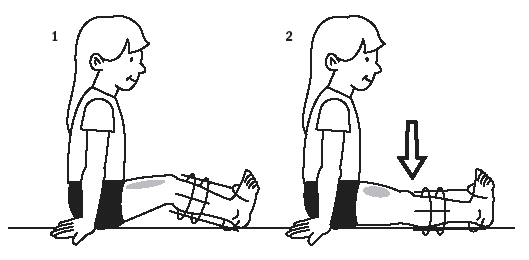We need to move our bodies to keep our bones and muscles fit and strong, so exercise and movement are very important during the treatment. From the first days after surgery, exercise and correct positioning are very important to prevent joint and muscle tightness. The physiotherapist will show your
child exercises to do in hospital and for when you go home.
Night positioning/positioning in
bed
When lying on the back, the knee should generally be positioned fully straight. The foot should be elevated on pillows to minimise swelling. Be sure there is no pressure on the heel.

Figure 1
Sometimes toe slings may be attached to the Ilizarov frame to hold the toes straight.

Figure 2
These should be removed every couple of hours to check the skin and allow some active movement.
Sitting
It is recommended that the foot remains elevated as much as possible to minimise swelling for the first few weeks. If a wheelchair is used, a leg board may be hired from the hospital to support the foot in elevation.
Figure 3
Walking
The Orthopaedic Surgeon will discuss whether your child may walk using crutches or a walking frame. Usually, the child is not allowed to put weight through the affected foot. If advised, the Physiotherapist will teach the child to walk with the most suitable gait aid - crutches or walking frame
may be hired from the hospital.

Figure 4
Exercises
To be practised at least 4
times daily.
1. Static quads: Tighten
the muscle on top of thigh. Push the back of your knee down to bed.
Be sure the knee is fully straight. Hold for 3-5 seconds X
10.

Figure 5
2. Hip-knee
bends: Slide the heel up the bed and down. Assist child as necessary. X 10.

Figure 6
3. Active movement of
toes: Pull toes back towards face, then curl toes down towards the bed. X 10.

Figure 7
4. Toe
stretch: Stretch toes gently back towards face. Hold for 30 seconds. Assist child as necessary. Repeat X 2.

Figure 8
5. Hamstring
stretch: Tuck right/left heel near groin with the opposite leg straight. Reach down until a stretch is felt in back of thigh. Hold for 30 seconds X 2.

Figure 9
OR
Long sitting: The young child may long sit for 5-10 minutes or as tolerated.

Figure 10